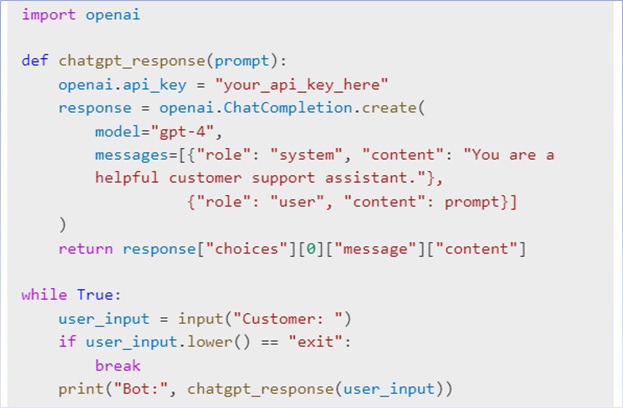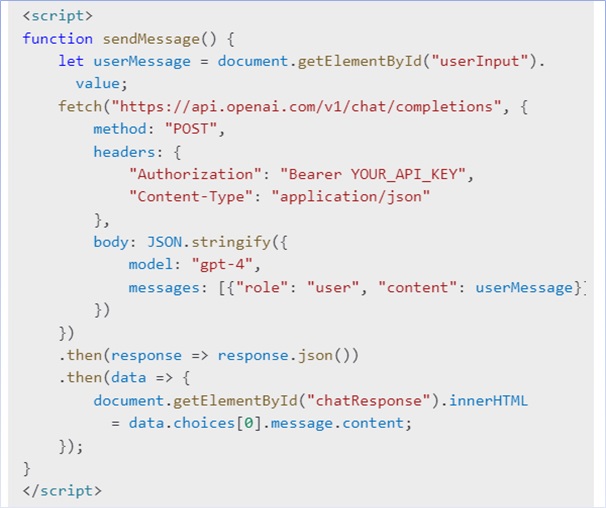
- ChatGPT - Home
- ChatGPT - Fundamentals
- ChatGPT - Getting Started
- ChatGPT - How It Works
- ChatGPT - Prompts
- ChatGPT - Competitors
- ChatGPT - For Content Creation
- ChatGPT - For Marketing
- ChatGPT - For Job Seekers
- ChatGPT - For Code Writing
- ChatGPT - For SEO
- ChatGPT - For Business
- ChatGPT - Machine Learning
- ChatGPT - Generative AI
- ChatGPT - Build a Chatbot
- ChatGPT - Plugin
- ChatGPT - GPT-4o (Omni)
- ChatGPT in Excel
- ChatGPT for Test Automation
- ChatGPT on Android
- Make Money with ChatGPT
- ChatGPT for UI/UX Designers
- ChatGPT for Web Developers
- ChatGPT for Data Scientists
- ChatGPT for Bloggers
- ChatGPT for Personal Finance Management
- Automate Customer Support with ChatGPT
- Create Content Calendars with ChatGPT
- Plan Events and Trips with ChatGPT
- Draft Legal Documents with ChatGPT
- Improve Your Coding Skills with ChatGPT
- New Language with ChatGPT
- Optimize ChatGPT Responses for Better Accuracy
- ChatGPT Useful Resources
- ChatGPT - Quick Guide
- ChatGPT - Useful Resources
- ChatGPT - Discussion
Automate Customer Support with ChatGPT
Delivering outstanding customer support is essential for businesses, yet managing inquiries manually can be both time-consuming and costly. By automating customer support with ChatGPT, you can simplify responses, lessen the workload, and enhance customer satisfaction. In this guide, we will guide you through the steps to set up ChatGPT for automated customer support.
Step 1: Define Your Customer Support Needs
Before you use ChatGPT, you should clearly define the scope of your customer support automation. Consider the following questions.
- What are the most typical questions from customers?
- Will ChatGPT provide technical support, FAQs, and order tracking?
- Should ChatGPT be set up to escalate difficult issues to human agents?
- What platforms do your customers often use?
Creating a list of common client queries will help you adapt ChatGPT's responses for maximum effectiveness. Furthermore, identifying consumer pain points will enhance the chatbot's functionality.
Step 2: Choose a ChatGPT Platform
You can use ChatGPT in a variety of ways depending on your needs and technical skills −
- OpenAI API − This is the ideal solution for those who want to integrate it with their existing systems.
- Chatbot platforms − (such as Dialogflow, ManyChat, and Chatfuel) are ideal for non-technical users that want an easy-to-use interface.
- Custom Development − If you have a developer available, you can integrate ChatGPT into your website or mobile application.
- Pre-Built Chatbots − You may also look into ready-made chatbot solutions that include ChatGPT connectivity.
Step 3: Set Up ChatGPT Using OpenAI API
If you opt for the OpenAI API, follow these steps −
Get API Access
- Go to OpenAI's website and sign up for an API key.
- Navigate to the API dashboard and generate an API key.
Install Required Libraries
If you're using Python, install OpenAI's library −

Write a Basic Chatbot Script
This script allows real-time conversation with ChatGPT.

Step 4: Train ChatGPT with Custom Data
To make ChatGPT more effective, train it with customer support data −
- Create a Knowledge Base − Gather FAQs, past chat logs, and documentation.
- Fine-Tune Responses − Use OpenAI’s fine-tuning process to customize responses.
- Provide Context − Include company-specific details in API prompts.
- Implement Sentiment Analysis − Improve responses by analyzing customer emotions.
Take a look at this Example API Call with Context −

Step 5: Deploy ChatGPT on Multiple Channels
To maximize ChatGPT’s utility, deploy it across different communication channels −
- Embed ChatGPT on your website for live chat.
- Integrate ChatGPT with Facebook Messenger, WhatsApp, or Telegram on social media.
- Automate email responses using ChatGPT for email support.
- Connect ChatGPT with Zendesk, Freshdesk, or HubSpot for seamless customer service in helpdesk systems.
- Explore voice-enabled ChatGPT to enhance accessibility with voice assistants.
For website integration, you can use JavaScript −

Step 6: Monitor and Improve ChatGPT’s Performance
Keep an eye on these key metrics −
- Response Time − Evaluate the speed at which ChatGPT replies.
- Customer Satisfaction − Collect user feedback to understand their experience.
- Escalation Rate − Determine how frequently ChatGPT refers inquiries to human agents.
- Accuracy Rate − Monitor the ratio of correct to incorrect responses.
Refine the Responses by taking the following actions −
- Regularly update the knowledge base.
- Train ChatGPT with new data.
- Adjust API parameters to improve response accuracy.
- Use A/B testing to compare the performance of the chatbot across different response models.
Step 7: Ensure Security and Compliance
Since customer support may involve sensitive data, ensure ChatGPT follows security best practices −
- Data Privacy − Do not store sensitive customer data.
- GDPR & CCPA Compliance − Ensure compliance with data protection laws.
- Access Controls − Restrict API access to authorized users only.
- Encryption − Use secure encryption protocols to protect communication data.
Conclusion
Automating customer support with ChatGPT significantly improves efficiency and reduces operational costs. By defining your support needs, integrating ChatGPT with different platforms, and continuously improving responses, you can create a seamless and responsive customer service experience. Implementing advanced monitoring, sentiment analysis, and A/B testing will further enhance your chatbot’s effectiveness.